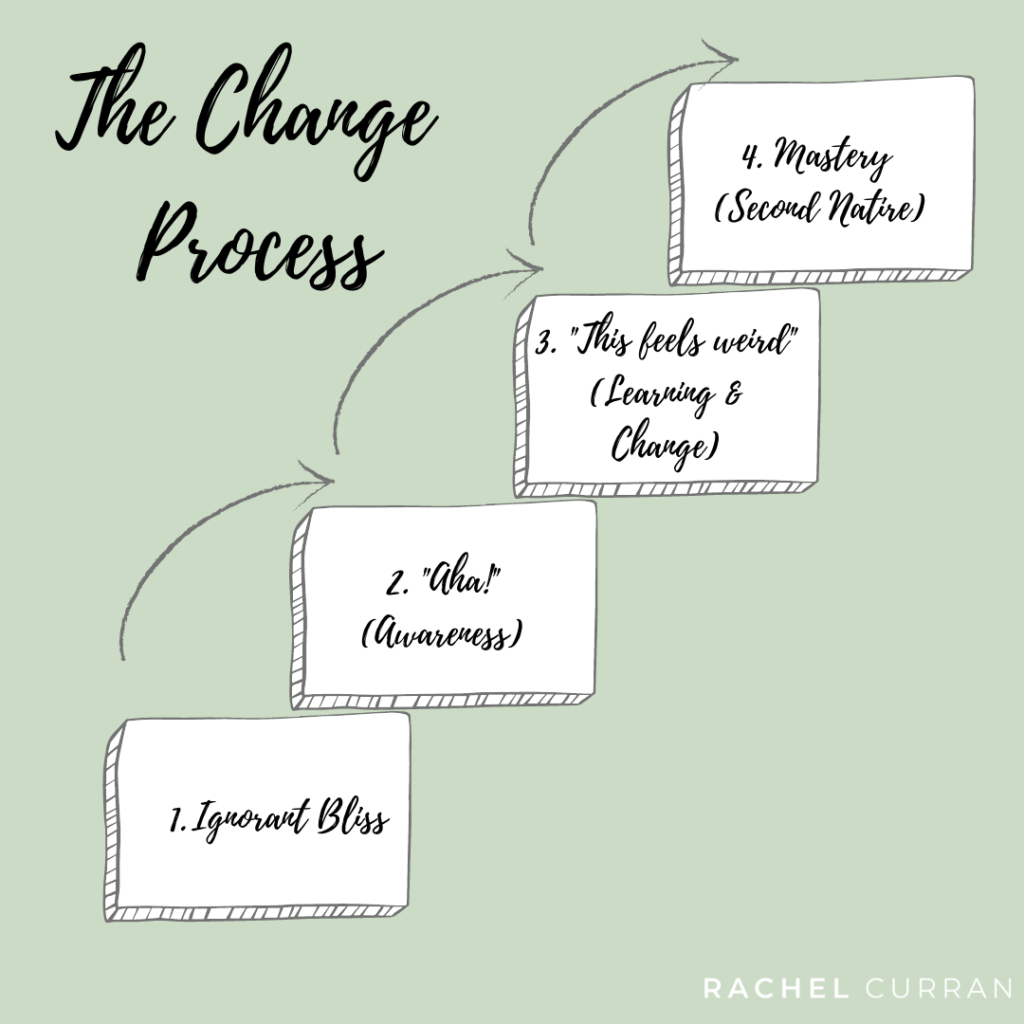
So, we know we are holding ourselves back from what we want, we know we have X behaviour that isn’t benefitting us, we know what we want instead of X behaviour, but how do we change?
First of all let me describe the Change Process, then I’ll explain what this really means for you:
THE CHANGE PROCESS 🤓

Stage 1: Ignorant Bliss 🙃 (AKA Unconscious Incompetence) – here we have no idea that we are doing something that doesn’t benefit us (e.g. overthinking 😖, feeling responsible for other peoples feelings 😰, blaming other people for our current reality 🤬, scared to make mistakes etc.).
Stage 2: “Ah, I’m doing this thing that doesn’t benefit me” 😲(AKA Conscious Incompetence) – we become aware that some of our current behaviours are not good for us.
Step 3: “This is uncomfortable” 😳 (AKA Conscious Competence) – we start to repeatedly do things different on purpose that are good for us, even though it feels weird, uncomfortable, and different and waaaaay outside of our comfort zone (e.g. speaking up when someone has crossed a boundary, saying “No” when we don’t want to do something, taking responsibility for our actions when in the past we would have blamed others).
Cool Tip: in Step 3 we are rewiring the brain! 🧠
Stage 4: “I’m doing stuff differently automatically! Cool!” 🤩 (AKA Unconscious Competence) – suddenly we catch ourselves f in the act of doing things differently that benefit us, that used to feel uncomfortable in Stage 3, but now they feel normal and we feel great 🙌🏻.
What is happening inside my brain?
Step 3 is all about creating new neural pathways and rewiring your brain.
In English please!
Right now your brain is really, really good at doing that thing that doesn’t benefit you. It’s had lots of practise! We were only born with two fears (loud noises and falling), so at whatever point we learnt to make a decision about life that does not benefit us (e.g. I am responsible for other people’s feelings, I cannot fail, blazing other people for our own mistakes etc.) we have been practising and practising and practicing that thinking until now. So for 23, 37, 42, or 97 years you have been repeating and repeating being responsible for other people’s feelings, not failing, blaming other people etc. So you are really, really good at it!
This pathway in your brain, from stimulus to response (someone is upset – I need to save, something went wrong – it’s their fault) is really strong, because like a muscle, we have been exercising sometimes hundreds of times a day! So even though it may not benefit us, we’ve practised it so much, we are now a pro. Also, although it may not benefit us, our brain and unconscious have learned that this behaviour is ‘safe’ (notice I did not day good or beneficial).
Why we make decisions about the world that don’t benefit us is a whhhhoooollllleeeeee other story which you can find out more about here XXX.
In step 3, we are consciously and on purpose doing something different. So the stimulus happens (someone is upset, a new challenge presents itself, things don’t go to plan), and instead of responding like we usually do (saving, making sure we don’t make a mistake, blaming), we instead chose to respond differently in a way that benefits us (allow people to be responsible for themselves, allow ourselves to make a mistake, take responsibility for own mistakes).
By choosing a different response to the same stimulus we create a new link in our brain, between the stimulus (thing that happens) and the choice of available responses (we can carry out old behaviour, or new one).
The link between the stimulus and the old response is like a very strong muscle, because we have worked it so much! The link between the stimulus and the new response is like a tiny baby muscle. Because of this, it feels easier every time we are faced with the stimulus to use our very strong muscle, rather than use our baby muscle. THIS IS THE KEY! Although it feels easier to use the old muscle, we now know that it isn’t benefiting us, and the small baby muscle is much better for us. Our goal is to build up the baby muscle so that it becomes even bigger and stronger than the old muscle, so that suddenly, our r=brain will start choosing the new stronger muscle than the old one.
Sounds easy, right?
If i can get you to leave here knowing anything it’s this:
Step 3 is wildly uncomfortable.
Choosing to use the small baby muscle instead of the old stronger muscle (which we have taught ourselves is ‘safe’) goes against everything we know, and can feel like an out of body experience. THIS IS NORMAL! And EVERYBODY in step 3 feels it.
The vast majority of people are in step 2 (know what is holding them back from achieving their full potential), want and know what step 4 is (know what would allow them to achieve their potential), but don’t want to commit to step 3 (feel uncomfortable).
We know it takes approximately 21 repetitions for a new neural pathway to form in the brain, so we can expect to feel uncomfortable at least 21 times.
The truly great people expect the uncomfortableness and do it anyway.
What does Step 4 feel like?
But, on the other side of the uncomfortableness, once the baby muscle has overtaken the old muscle we suddenly find ourselves acting out a new behaviour without thinking.
And what’s even cooler is that suddenly, that old response that we used to have, now THAT feels uncomfortable, and we almost feel compelled to use our new stronger response,
Most people spend their lives stuck at Stage 2 – will you be one of those people?
The truly great people expect the uncomfortableness and do it anyway.





